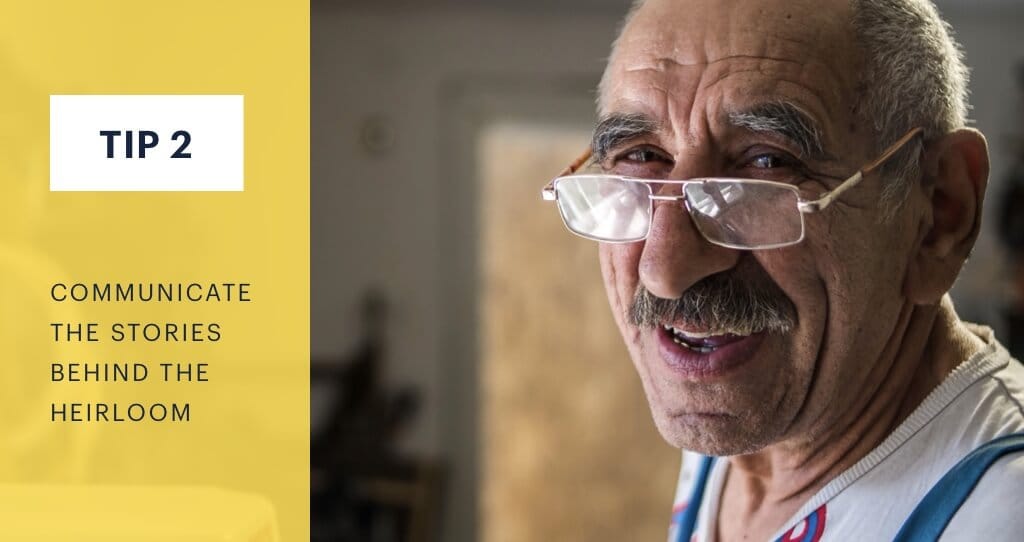Family Heirlooms: A Complete Preservation Guide
When my parents and grandparents were alive, I never questioned my identity. It was always clear that I belonged to my family as their child and grandchild. However, once I was left without my ancestors, I began to have many more questions about myself, my family heritage and our family heirlooms.
Following my mother’s passing, I inherited all the family heirlooms as a single child. Due to space constraints, I selected specific items to keep for myself and my children—objects that I can see daily, providing me with a sense of belonging and evoking memories of the love they represent.

When preserving family history and passing down items that belonged to our ancestors from one generation to the next, it’s important to take the necessary steps to protect these sentimental pieces. From antique jewellery and vintage clothing to timepieces and handmade furniture, each item holds a unique story that connects us to our past. Whether it’s your grandfather’s pocket watch or your grandma’s crystal necklace, these family heirlooms are a precious part of a lasting family legacy.
In this article, we guide you through identifying, preserving and documenting your family heirlooms, along with their backstories—so these treasures can be cherished by your children, grandchildren, and beyond.
Jump to section:
- What Are Family Heirlooms and Why Are They Important?
- How to Identify Valuable Family Heirlooms?
- How to Preserve Different Types of Heirlooms?
- Tips for Passing Down Family Heirlooms
- Preserve Your Family Heritage in the Digital Age
What Are Family Heirlooms and Why Are They Important?
Every family has different types of heirlooms. It does not necessarily have to be jewellery; it can also be china, linens, glassware, recipe books, photos, or any object that has been important in the life of an ancestor.
My grandparents collected porcelain figures and loved porcelain cups and plates. They also bought sets of these for my mother and aunt, so when I inherited all of them, it was a pretty remarkable collection. However, after 50 years, the use of these has practically disappeared from households, and their value has completely plummeted compared to the 1970s and 1980s.
I am convinced that guarding family heirlooms is crucial. They serve as tangible links to our past, embodying the stories, cultures, and values of our ancestors.
Therefore, I have kept some porcelain figurines and vases from the extensive collection and even gifted some to my children, so they can keep a memory of their grandmother and great-grandparents in their rooms.
Understand the significance of family heirlooms
I believe that these treasured possessions offer a unique sense of identity and belonging, grounding us in our heritage and providing a sense of continuity across generations.
By preserving and cherishing these items, we maintain a connection to our lineage, fostering a deeper understanding of where we come from and who we are. Moreover, the sense of understanding our roots and identity derived from heirlooms can promote psychological well-being, making us healthier personalities with more self-knowledge.
Types of family heirlooms to preserve
My grandma had a gold necklace with a cross that my mother had been preserving for years before I inherited it. I plan to give this chain to my daughter, carrying on a cherished female tradition in my family. I believe it’s crucial to discuss these heirlooms with our children, informing them of their significance — be it financial or emotional. This knowledge fosters an emotional connection, ensuring they cherish and preserve these treasures for future generations.
Preserve the history, memories, and emotional connection between generations by thinking through what are or can be your family heirlooms. Here’s a list starting with the more common ones and moving towards the less common ones.
Common family heirlooms
Our most treasured family heirloom are our sweet family memories. The past is never dead, it is not even past.
— William Faulkner
- Jewellery: Rings, necklaces, and brooches that often have nostalgic value or are associated with significant life events.
- Watches: Especially pocket watches and wristwatches passed down through generations.
- Photographs and photo albums: Capturing moments in time, these are treasured for their historical and emotional value.
- Quilts and blankets: Handmade items that carry personal and cultural stories.
- Books: Especially first editions, signed copies, or books that have been in the family for generations.
- Furniture: Pieces like rocking chairs, armoires, or dining tables that have been in the family for years.
- China sets: Often passed down from generation to generation, especially pieces used during special occasions.
- Silverware: Sets that are brought out for special occasions, often engraved or of particular craftsmanship.
Less Common Family Heirlooms
- Letters and diaries: Personal writings that offer insights into our ancestors’ daily lives and emotions.
- Military memorabilia: Medals, uniforms, or other items associated with family members’ military service.
- Recipe books: Handwritten family recipes passed down, preserving culinary traditions.
- Musical instruments: Especially those with a story or played by family members across generations.
- Land deeds and maps: Documents showing the history of family properties or migrations.
- Hair lockets or mourning jewelry: Victorian-era items that contain the hair of deceased loved ones, symbolising remembrance.
- Tools or craft items: Items from a family trade or craft, symbolising the family’s work history.
- Wedding dresses or christening gowns: Garments worn on special occasions, sometimes altered to fit new generations.
- Seed collections: For families with a history of gardening or farming, seeds from plants that have been cultivated for generations.
- Art pieces: This could include paintings, sculptures, or other works created by family members or acquired in a way that holds special meaning.
In families where sharing stories or talking about the past is uncommon, we might stumble upon surprising information about our inherited objects. While going through my mother’s flat I found some aged, brownish, hand-made photo books with pictures of a private theatre group, where my grandfather, my aunt and my mother played together with others for example in Shakespeare’s Othello.
Connect generations with family heirlooms
Family heirlooms are like tangible hugs from the past, linking generations through shared memories and stories. Each piece carries whispers of laughter, tears, and love from ancestors we may have never met.
These treasures foster a sense of belonging and identity, grounding us in our family’s history while inspiring us to add our own chapters.
Understanding the history behind these cherished objects also enriches children’s appreciation for their heritage, fostering a deep connection to their familial past. Additionally, knowledge of these heirlooms’ stories and values can instil a sense of responsibility and pride in preserving family traditions for future generations.
How to Identify Valuable Family Heirlooms?
Identifying valuable family heirlooms involves a blend of research, intuition, and sometimes professional advice. Here are key steps to help you determine the value, both sentimental and monetary, of family heirlooms:
- Research the history: An item’s backstory can significantly influence its value. Items with a documented history, provenance, or connection to significant events or figures are often more valuable. You can start by talking to family members to gather stories or any documentation related to the heirloom.
- Inspect for marks and signatures: Many valuable items, like jewellery, art, and antiques, may have maker’s marks, hallmarks, signatures, or dates. These can provide clues about the creator, origin, and age, which are critical factors in determining value.
- Assess condition: An item’s condition greatly affects its value. Look for signs of wear, damage, or repairs. In some cases, original condition—even with wear—adds to the item’s history and appeal, whereas repairs or alterations can reduce its value.
- Identify unique characteristics: Look for distinctive features that might set an item apart, such as rare designs, materials, or craftsmanship. Unusual or unique items often have higher value due to their scarcity.
- Compare similar items: Researching auction sites, antique shops, and collectors’ forums can provide insight into the value of similar items. Keep in mind that market trends can fluctuate, so what’s highly valuable now might not be in the future, and vice versa.
- Understand sentimental value: An item’s worth is sometimes more about the stories and memories it carries than its monetary value. This intrinsic value can make an heirloom priceless to a family, regardless of its market value.
- Consult professionals: If you suspect an item might be of significant value, consider consulting an appraiser or an expert in the relevant field. They can provide a professional evaluation based on current market trends and the item’s condition, provenance, and rarity.
Losing loved ones exacts a profound toll on each of us, yet we navigate the deep waters of grief in our own unique ways.
My guidance for sorting through inherited objects is to refrain from doing so prematurely, before the intensity of your sorrow feels overwhelming. Premature actions can lead to decisions you might later regret.
For instance, sorting through my mother and grandmother’s collection of vases and china was so heart-wrenching that I was tempted to sell much of it swiftly. During this process, I sold several items for a minimal sum, including an éozine vase I had always disliked as a child. That same evening, my husband discovered the vase’s significant value online. The next day, he managed to repurchase it from the second-hand dealer at the original price. This experience taught me the importance of allowing myself more time before handling the remainder of their belongings.
Remember, the process of identifying valuable inherited treasures can be as enriching as it is enlightening, offering a wonderful opportunity to connect with your heritage and preserve it for future generations.
How to Preserve Different Types of Heirlooms?
- Start by organising your family heirlooms in a safe place, such as a jewellery box, china cabinet, or souvenir cabinet.
- Protect family heirlooms. For example, for antique furniture and fine china use padded covers or shelves to prevent chips and cracks.
- For items with sentimental value, such as handwritten letters, photographs, and newspaper clippings, consider storing them in acid-free archives to prevent deterioration over time.
- When storing more fragile items like silverware or cookbooks, keep them in a dry environment to prevent corrosion.
- Keep antique jewellery pieces separate to prevent tangling or damage. Wrap delicate items like necklaces and bracelets in soft cloth to avoid scratches.
Tips for Passing Down Family Heirlooms
While my mother lacked a formal plan for distributing the family heirlooms, I stumbled upon a document penned by my grandmother while clearing out her apartment. In it, she meticulously outlined which pieces of jewellery should be passed to which daughter. Remarkably, I was also included in these plans, albeit indirectly, as she advised my mother to preserve my grandfather’s stamp collection for me. A story I have never known.
Tip 1 – Create a family heirloom succession plan
If you’ve always felt a bit overwhelmed by the mountains of clutter that seem to fill every nook and cranny of your entire house, here’s an idea that might get you started on the path to organisation and creating something timeless for your family.
How about putting together a family heirloom succession plan?

Think about all the fond memories attached to the various heirlooms scattered throughout your home. That portrait of your great-grandmother from the 19th century, the bible passed down from your great uncle, or the handcrafted earrings your dad’s great-grandfather gave his great-grandmother.
These items may find a more appreciative caretaker in your family than hidden away in a cardboard packet somewhere.
At your next family reunion, why not bring up the idea of creating a plan for who will inherit each family heirloom? You could even assign each item to a specific family member who has always shown a particular fondness for it. That way, those tablecloths, clocks, watches, and charms won’t end up in the hands of another family.
By embroidering the history and significance of each heirloom into your family’s story, you can cheer up your home and ensure that these treasures are still used and appreciated for years to come. By ensuring a fair distribution among family members, you can make everyone happy and feel connected to their heritage. And who knows, maybe one of those trinkets will turn out to be worth more than 50 cents at some point!
Tip 2 – Communicate the stories behind each family heirloom
Objects that hold personal significance, with known origins and historical context, are more meaningful to people than those without.
Preserving these objects becomes significantly more meaningful when we possess information about them. Hence, I believe it’s crucial for parents to share these stories with their children and grandchildren sooner rather than later, enriching their connection to these pieces and ensuring their legacy continues.

Have I ever told you about all the fascinating stories behind each family heirloom we have? Take this pin for example; it was owned by my great grandmother who wore it on her wedding day over 100 years ago. And this wedding china? It was a gift from my great-uncle to my great-grandfather back in the early 1900s. Oh, and let me tell you about this biscuit recipe handed down from my grandmother that we still bake on family occasions…
Each piece holds memories and stories, freshly passed down from the original owner.
Preserve Your Family Heritage in the Digital Age
I am very anxious to have photos of my parents and me from my childhood in boxes stored up high and never opened. I can’t wait to start digitising them so that I can look at them and share them with my kids more easily!
If you are keen on preserving family heritage, such as your grandmother’s old photos from the 1800s, instead of letting them collect dust in an old album, why not digitise them and create a digital family archive? You can share them with relatives all over the world and ensure they’re never lost.
Plus, it’s a fun project that brings the whole family together!
Digitise family heirlooms for future generations
Digitising family relics is definitely a big job, however you can ensure their preservation and accessibility for future generations. Here are some ways to achieve this:
- Photographing or scanning: Capture high-quality photographs or scans of physical items like letters, photographs, jewellery, and artwork. Use a scanner for flat items and a camera for three-dimensional objects, ensuring good lighting and focus.
- Creating digital archives: Store these digital copies in organised folders on a computer or a dedicated external hard drive. Use descriptive file names and include metadata like dates, names, and the item’s history.
- Video recording: Record video narratives of family members sharing stories and memories associated with each heirloom. This adds a personal touch and preserves the oral history of the item.
- Using cloud storage: Upload the digital files to a cloud storage service to safeguard against data loss from hardware failure. Ensure it’s a reputable service with strong security measures.
- Developing a digital inventory: Compile a detailed inventory of the heirlooms in a digital document, including photos, descriptions, the significance of each item, and any known history. This can be shared and updated easily among family members.
- Setting up a family website or blog: Share the digitised collection with wider family members by setting up a dedicated website or blog. This can include images, stories, and the history behind each heirloom.
- Using social media: Create a private social media group or page where family members can share memories, photos, and stories about their shared heritage, including digitised heirlooms.
A comprehensive digital solution to treasure ancestral memories
When I asked a few friends about what they do to preserve cherished family photos and stories they came up with various answers such as using apps for family tree creation, adding photos on Google Drive, making photo albums, and writing journals. Here are eight ways to preserve stories for your family.
In my hectic life, I would rather look for a digital solution that can handle everything. With the Simirity app you can start collecting stories, photos, videos, and voice recordings on the same platform and share them with your family members to join the fun.
Not only you but also your loved ones can add entries of important events from their lives, so you can motivate your parents to leave a digital legacy to their grandkids.
The perfect way to keep everyone in the loop and create a lasting legacy of family stories to look back on.
Seen in the City


